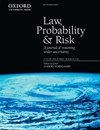Probability Distributions in R
IF 2.7
4区 社会学
Q1 LAW
引用次数: 0
Abstract
R allows you to use a wide variety of distributions for four purposes. For each distribution, R allows you to call the cumulative distribution function (cdf), probability density function (pdf), quantile function, and random draws from the distribution. All probability distribution commands consist of a prefix and a suffix. Table 1 presents the four prefixes, and their usage, as well as the suffixes for some commonly-used probability distributions.R中的概率分布
R允许您出于以下四个目的使用各种各样的发行版。对于每个分布,R允许您调用累积分布函数(cdf)、概率密度函数(pdf)、分位数函数和分布中的随机抽取。所有概率分布命令都由前缀和后缀组成。表1给出了这四个前缀及其用法,以及一些常用概率分布的后缀。
本文章由计算机程序翻译,如有差异,请以英文原文为准。
求助全文
约1分钟内获得全文
求助全文
来源期刊

Law Probability & Risk
MATHEMATICSSTATISTICS & PROBABILITY&-STATISTICS & PROBABILITY
CiteScore
2.10
自引率
28.60%
发文量
8
期刊介绍:
Law, Probability & Risk is a fully refereed journal which publishes papers dealing with topics on the interface of law and probabilistic reasoning. These are interpreted broadly to include aspects relevant to the interpretation of scientific evidence, the assessment of uncertainty and the assessment of risk. The readership includes academic lawyers, mathematicians, statisticians and social scientists with interests in quantitative reasoning.
The primary objective of the journal is to cover issues in law, which have a scientific element, with an emphasis on statistical and probabilistic issues and the assessment of risk.
Examples of topics which may be covered include communications law, computers and the law, environmental law, law and medicine, regulatory law for science and technology, identification problems (such as DNA but including other materials), sampling issues (drugs, computer pornography, fraud), offender profiling, credit scoring, risk assessment, the role of statistics and probability in drafting legislation, the assessment of competing theories of evidence (possibly with a view to forming an optimal combination of them). In addition, a whole new area is emerging in the application of computers to medicine and other safety-critical areas. New legislation is required to define the responsibility of computer experts who develop software for tackling these safety-critical problems.
 求助内容:
求助内容: 应助结果提醒方式:
应助结果提醒方式:


